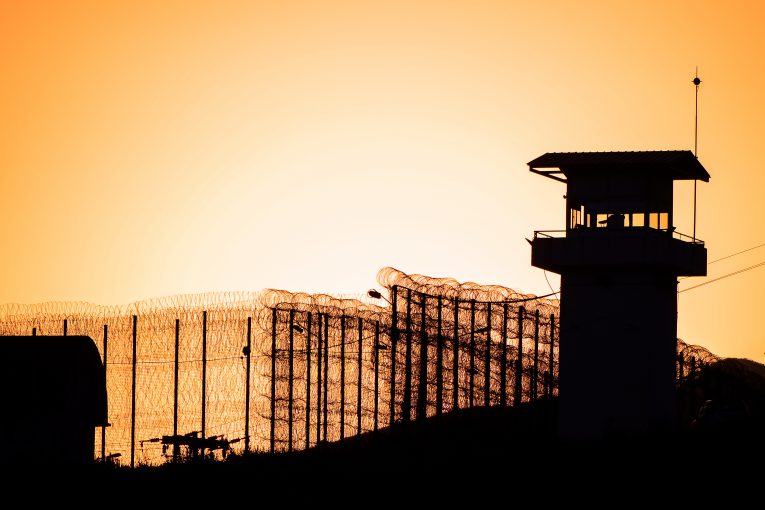


by Jesús Trujillo
My world, my reality, is composed of concrete, cement, cold impersonal metal, deadly electrical fences, and blood-drenched soil.
I’m not your typical Chicano serving a life sentence. For one, my violence-free prison record is almost impossible if one is: young (under 21 when arriving to prison), a Mexican-American gang member (though I’ve severed those ties), and serving a life sentence (a euphemized death sentence). The people on this side of the wall are in a sense a product of their environment: impersonal like concrete, cold like the metal, and deadly like the lethally electrified fence that serves as a moat of sorts. Escape is not an option; that’s only on the lower levels. Being an inmate who is serving a 50-years-to-life sentence, I’m destined to spend my days in a maximum security prison inspired by the benevolent J. Bentham. Actually, I no longer have a 50-years-to-life sentence—I’m now serving a 15-years-to-life sentence.
You see, the governor of California saw a redeemable quality in me that I was both ashamed to admit (for how could I, a 17-year-old murderer, change?) and yet desperate to reveal to the world, the world of the free.
This shame I speak of is fed by fear. Change is a natural process of life, but in prison change means something foreign to the normal person. One has to learn to negotiate multiple identities to survive; we wear masks that have been molded by our upbringing. Prison just becomes a natural phase in our life.
What I mean by “negotiate identities” is first, we are broken down by age: Prison for adults, juvenile hall for kids (except when tried as adults as in my case). Then sex: males and females. Then offense: violent offenses are punished (corrected), not rehabilitated; lesser crimes are rehabilitated.
Once these categories determine your prison, the unwritten rules break you down into  smaller, more serious categories: general population (“GP”), considered “active” yards, or sensitive needs yards (“SNY”). Each has its own dynamic and I can only speak of GP yards. These two yards hate each other, and if misplaced, it can be the end of you. Once put on a GP yard, you have to choose who you run with: Black, White, Mexican, Other, Native American. Then these are broken down further: Blacks into Crips or Bloods or non-affiliated or even Muslim; Whites into Skinheads, Woods (ordinary white guys for the most part), Nazi Lowriders, and Aryan Brotherhood (a prison gang separate from all white subcategories); Mexicans into Southerners, Northerners, Bulldogs (Central Californians, like from Fresno), Paisas (Mexican nationals), and Christians (who do not participate in any illegal acts, except in riots they are obligated to respond or else they face punishment), and the Mexican Mafia or “Eme” (a prison gang separate from all Mexican subcategories); then there’s the Others, mostly different Asian ethnicities, some are nationals, others are gang members. Plus, the Native Americans, who are separate from all the different groups. Such division makes it easier for violence to occur, and unity is strictly within one’s race and even then there are power trips that result in melees.
smaller, more serious categories: general population (“GP”), considered “active” yards, or sensitive needs yards (“SNY”). Each has its own dynamic and I can only speak of GP yards. These two yards hate each other, and if misplaced, it can be the end of you. Once put on a GP yard, you have to choose who you run with: Black, White, Mexican, Other, Native American. Then these are broken down further: Blacks into Crips or Bloods or non-affiliated or even Muslim; Whites into Skinheads, Woods (ordinary white guys for the most part), Nazi Lowriders, and Aryan Brotherhood (a prison gang separate from all white subcategories); Mexicans into Southerners, Northerners, Bulldogs (Central Californians, like from Fresno), Paisas (Mexican nationals), and Christians (who do not participate in any illegal acts, except in riots they are obligated to respond or else they face punishment), and the Mexican Mafia or “Eme” (a prison gang separate from all Mexican subcategories); then there’s the Others, mostly different Asian ethnicities, some are nationals, others are gang members. Plus, the Native Americans, who are separate from all the different groups. Such division makes it easier for violence to occur, and unity is strictly within one’s race and even then there are power trips that result in melees.
Another harsh reality about prison in California is the brutal means Mexicans and often whites use to enforce their rule. I came to prison at the age of 18, and a still-active gang member. The majority of stabbings and two-on-one assaults are perpetuated by Chicanos. Knowing this, I felt it was not a matter of if but when I would be called upon to commit an act of violence to earn my meaningless “stripes.” Based on my interactions with more hardened, seasoned “big homies,” I see that they take pride in their acts of violence. They compared their selfish violence with the great and brave Aztecs who were vicious and bloodthirsty. In fact, Aztecs are so revered in here that when placed in the hole (administrative segregation) one is expected to learn Náhuatl, the language of the Mexica. Cultural pride is distorted from something as beautiful as the Mexican/Aztec stone calendar to its central figure, the face of the bloodthirsty Tonatiuh with his tongue represented in the form of an obsidian blade. I was being molded to be as hard as stone, as sharp as metal, and to strike like deadly voltage. I was told I would have to do one act of violence within my first three years.
In Gloria Anzaldúa’s Entering into the Serpent, she somewhat explains a time when Aztec culture was focused on the principle of balanced opposition between the sexes. But that was lost to the cult of Huitzilopochtli, the Aztec god of war. He said to the Azteca-Mexica people, “Therefore, I have come as one charged with a special duty, because I have been given arrows and shield, for waging war is my duty.”
One way I managed to stay out of trouble so far, besides dropping my gang ties, was my sober life. I estimate that 80% of beatings, stabbings, riots, and negative tension stems from drugs and drug debts. For obvious reasons, a drug dealer can’t tell the officers he’s been swindled by a basehead for $300, so justice is taken into his hands. And violence is not a solo act: it requires an aggressor and victim. So, if you owe money, you can either stab somebody for the dealer, or get stabbed; either way your debts are cleared.
My desire to change was in direct conflict with my instinct to survive—I would rather victimize than become a victim. As a child who was beat and abused I was tired of being a victim. Being poor led to ridicule. I needed to fit in, and education made me a good kid but not a cool kid. So I focused my energy on gangs, and at the age of 13 I was a gang member. By 17 I was facing life imprisonment for murder.
So prison became my reality, and violence was the universal solve-all in this place. To some, death was better than serving decades in prison only to die alone, rejected and forgotten. Cement, steel, and dirt are my ecosystem.
I had to look inside myself in order to transcend the concrete, steel, and that deadly electrified fence. Education, both academic and spiritual, aided in my metamorphosis. College gave me a sense of accomplishment and meaningful goals, while self-help classes helped my struggling identities of inmate, son, convict, student, killer, reformer. I was labeled, but I learned labels are just that, they only have power when fed into. I learned the power of self-affirmation and the responsibility I now have to give back the good that was given to me.
You see, I was initially given knowledge of a destructive nature by those lost souls, and I was on the verge of losing myself to my newly given identity: AL2029. I said, “No, I’m not just a number, and even if I never get released I will die happy knowing I’ve tried.” I soon found myself with a tangible purpose: I was training service dogs for veterans with PTSD, received an AA degree from Feather River College, and now teach self-help classes to the Spanish-speaking inmates who would otherwise have no other classes to attend.
Recently, I’ve witnessed the unthinkable only ten years ago: Different races playing sports together and sitting on the same dayroom tables. Now that release to lifers is more than an illusion, people like me are motivated to change—there is a reward for such behavior.
50 years to life seems like a nightmare when I ponder on the relief given to me by Governor Brown. Hope and forgiveness motivated me and helped me think outside of my barbed wire concrete box. My autobiography is not unique. What is unique is I was given a second chance to possibly live in society. My path was not easy, and at times I almost faltered; but my hope is to help other teens coming in to see what I now see.
Republished from “Perspectives from the Cell Block: An Anthology of Prisoner Writings” – edited by Joan Parkin in collaboration with incarcerated people from Mule Creek State Prison.
